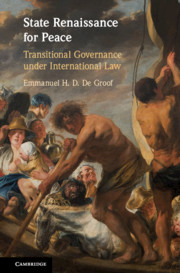Book contents
- Reviews
- State Renaissance for Peace
- State Renaissance for Peace
- Copyright page
- Dedication
- Contents
- Tables
- Foreword
- Preface
- Acknowledgements
- Additional material
- Abbreviations
- Introduction Transitional Governance Today
- Part I The Unchartered Territory of Transitional Governance
- Part II Foundation and Actors of Transitional Governance * Sources of Ius in Interregno
- 3 The Foundation of Transitional Governance
- 4 The Actors of the Interregnum
- 5 The Sources of Ius in Interregno
- Part III Self-Determination through Transitional Governance
- Part IV Moderating External Influence on Transitional Governance
- Index
5 - The Sources of Ius in Interregno
from Part II - Foundation and Actors of Transitional Governance * Sources of Ius in Interregno
Published online by Cambridge University Press: 10 September 2020
- Reviews
- State Renaissance for Peace
- State Renaissance for Peace
- Copyright page
- Dedication
- Contents
- Tables
- Foreword
- Preface
- Acknowledgements
- Additional material
- Abbreviations
- Introduction Transitional Governance Today
- Part I The Unchartered Territory of Transitional Governance
- Part II Foundation and Actors of Transitional Governance * Sources of Ius in Interregno
- 3 The Foundation of Transitional Governance
- 4 The Actors of the Interregnum
- 5 The Sources of Ius in Interregno
- Part III Self-Determination through Transitional Governance
- Part IV Moderating External Influence on Transitional Governance
- Index
Summary
As to the sources of ius in interregno, both stable and evolving norms applicable to TG should be considered. Individual customary rules are germinating in relation to TG but not in isolation from the existing principles of self-determination and non-intervention. As to the evolving part of ius in interregno, TI may testify to the emergence of custom. Both domestic laws, unilateral declarations, intrastate agreements or international conventions can be taken into account. Socialisation explains why these and other instruments incorporate TG-relevant patterns. The effects of dominant discourse and mimesis entice a common (legal) culture accounting for both the (socialised) origin of, and (legal) compliance with, specific behavioural patterns. This fertile breeding ground also explains why such patterns are formalised through the adoption of TI, which may or may not be valid on the domestic plane: compliance with international law is expected regardless of how the transition was triggered.
Keywords
- Type
- Chapter
- Information
- State Renaissance for PeaceTransitional Governance under International Law, pp. 150 - 190Publisher: Cambridge University PressPrint publication year: 2020

